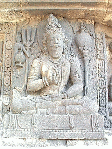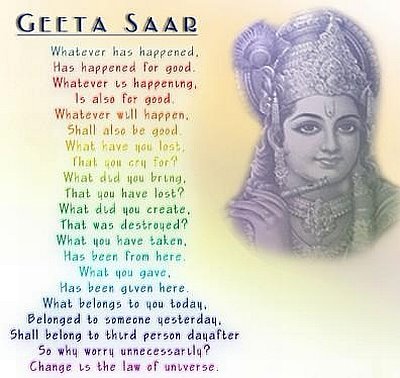Om Sai Ram
Below is a beautiful Shirdi
Sai Wallpaper for your computer ,laptop or your mobile phone.. Depending on your computer settings- the below wallpaper is
available in two dimensions -
What do you say about a gigantic temple complex, nearly 1200 years old, which has a huge Shiva temple, a huge Vishnu temple & a huge Brahma temple, all next to each other in fine splendour? It is unique in the world. And there are hundreds of small sized temples all around. This is at Prambanan, ten miles east of the Yogyakarta town in central Java , Indonesia
As the largest Hindu temple in Southeast Asia, the beautiful and graceful temple of Prambanan is a magnificent spectacle and an icon of Indonesia’s cultural heritage.
Located not far from the Buddhist Borobudur temple, the proximity of the two temples tells us that on Java, Buddhism and Hinduism lived peacefully next to one another. Historians suggest that the construction of Prambanan probably was meant to mark the return of the Hindu Sanjaya Dynasty to power in Central Java after almost a century of Buddhist Sailendra Dynasty domination.
Prambanan is a ninth century Hindu temple compound in Central Java, Indonesia, dedicated to the Trimurti, the expression of God as the Creator (Brahma), the Sustainer (Vishnu) and the Destroyer (Shiva).
A temple was first built at the site around 850 CE by Rakai Pikatan and expanded extensively by King Lokapala and Balitung Maha Sambu the Sanjaya king of the Mataram Kingdom. According to the Shivagrha inscription of 856 CE, the temple was built to honor Lord Shiva and its original name was Shiva-grha (the House of Shiva) or Shiva-laya (the Realm of Shiva).[
The present name Prambanan, was derived from the name of Prambanan village where the temple stood, this name probably being the corrupted Javanese pronunciation of "Para Brahman" ("of the brahmins"), doubtless an echo its heyday when the temple was filled with great numbers of brahmins.
In the 930s, the court was shifted to East Java by Mpu Sindok, who established the Isyana Dynasty. An eruption of Mount Merapi volcano, located north of Prambanan in central Java, or a power struggle probably caused the shift. That marked the beginning of the decline of the temple. It was soon abandoned and began to deteriorate.
The temples themselves collapsed during a major earthquake in the 16th century. Although the temple ceased to be an important center of worship, the ruins scattered around the area were still recognizable and known to the local Javanese people in later times. After hundreds of years of neglect, the Prambanan temple was rediscovered .The temple compound was expanded by successive Mataram kings such as Daksa and Tulodong with the addition of hundreds of perwara temples around the chief temple..
In 1811 during Britain’s short-lived rule of the Dutch East Indies, Colin Mackenzie, a surveyor in the service of Sir Thomas Stamford Raffles, came upon the temples by chance. Although Sir Thomas subsequently commissioned a full survey of the ruins, they remained neglected for decades, with Dutch residents carting off sculptures as garden ornaments and native villagers using the foundation stones for construction material. . Half-hearted excavations by archaeologists in the 1880s merely facilitated looting. Reconstruction of the compound began in 1918, and proper restoration only in 1930. Efforts at restoration continue to this day
The temple officially caught the international attention in early 19th century. However, The temple was damaged during the May 2006 Java earthquake. Early photos suggested that although the complex was structurally intact, the damage was significant. Large pieces of debris, including carvings, were scattered over the ground. The temple was closed to visitors until the damage could be fully assessed. Eventually, the head of Yogyakarta Archaeological Conservation Agency stated that it would take months to identify the precise extent of the damage. However, some weeks later in 2006 the site was re-opened for visitors. In 2008, 856,029 Indonesian visitors and 114,951 foreign visitors has visited Prambanan. In 6 January 2009 the reconstruction of Nandi temple finished. As of 2009, the interior of most of the temples remains off-limits for safety reasons.
As a unique cultural and architectural marvel, Prambanan was declared a World Heritage site in 1991 by UNESCO.
The ruins of Prambanan soon after their discovery.- 1895
The statue of Durga Mahisasuramardini in northern cella of Shiva temple.
The popular legend of Rara Jonggrang is what connects the site of the Ratu Boko Palace, the origin of the Durga statue in northern cell/chamber of the main shrine, and the origin of the Sewu temple temple complex nearby. The legend tells of the story about Prince Bandung Bondowoso who fell in love with Princess Rara Jonggrang, the daughter of King Boko. But the princess rejected his proposal of marriage because Bandung Bondowoso had killed King Boko and ruled her kingdom. Bandung Bondowoso insisted on the union, and finally Rara Jonggrang was forced to agree for a union in marriage, but she posed one impossible condition: Bandung must build her a thousand temples in only one night.
The Prince entered into meditation and conjured up a multitude of spirits (demons) from the earth. Helped by supernatural beings, he succeeded in building 999 temples. When the prince was about to complete the condition, the princess woke her palace maids and ordered the women of the village to begin pounding rice and set a fire in the east of the temple, attempting to make the prince and the spirits believe that the sun was about to rise. As the cocks began to crow, fooled by the light and the sounds of morning time, the supernatural helpers fled back into the ground. The prince was furious about the trick and in revenge he cursed Rara Jonggrang to stone. She became the last and the most beautiful of the thousand statues. According to the traditions, the unfinished thousandth temple created by the demons become the Sewu temple compounds nearby (Sewu means "thousands" in Javanese), and the Princess is the image of Durga in the north cell of the Shiva temple at Prambanan, which is still known as Rara Jonggrang or Slender Virgin.
An architectural model of the Prambanan temple complex, originally there was 240 temples stood in this temple compound
- 3 Trimurti temples: three main temples dedicated to Shiva, Visnu, and Brahma
- 3 Vahana temples: three temples in front of Trimurti temples dedicated to the vahana of each gods; Nandi, Garuda, and Hamsa
- 2 Apit temples: two temples located between the rows of Trimurti and Vahana temples on north and south side
- 4 Kelir temples: four small shrines located on 4 cardinal directions right beyond the 4 main gates of inner zone
- 4 Patok temples: four small shrines located on 4 corners of inner zone
- 224 Pervara temples: hundreds of temples arranged in 4 concentric square rows; numbers of temples from inner row to outer row are: 44, 52, 60, and 68
The multitude of temples scattered around Prambanan inspired the local legend of Rara Jonggrang
Candi Plaosan in Prambanan (9th century).In other words - Dvarapala, the giant guardian in front of Plaosan Temple.
Dvarapala (Sanskrit) is a door or gate guardian often portrayed as warrior or fearsome asura giant, usually armed with a weapon, the most common is gadha mace..... Thought to have been built by a Hindu king for his Buddhist queen.
The Shiva temple is the tallest and largest structure in Prambanan Loro Jonggrang complex, it measures 47 metres tall and 34 metres wide. The Shiva temple encircled with galleries adorned with bas-reliefs telling the story of Ramayana carved on the inner walls of the balustrades. To follow the story accordingly, visitors must enter from the east side and began to perform pradakshina or circumambulating clockwise. The bas-reliefs of Ramayana continued to Brahma temple galleries.
A three meter high statue of Shiva Mahadeva (the Supreme God)
Brahma Shrine
The two other main shrines are that of Vishnu on the north side of Shiva shrine, and the one of Brahma on the south. Both temple facing east and each contain only one large chamber, each dedicated to respected gods; Brahma temple contains the statue of Brahma and Vishnu temple houses the statue of Vishnu. Brahma and Vishnu temple measures 20 metres wide and 33 metres tall.
The temple is adorned with panels of narrative bas-reliefs telling the story of Hindu epic; Ramayana and Krishnayana
The story of Ramayana started on Shiva temple balustrade and continued to Brahma temple.The bas-relief of Ramayana illustrate how Sita, the wife of Rama, is abducted by Ravana. The monkey king Hanuman brings his army to help Rama and rescue Sita. This story is also shown by the Ramayana Ballet, regularly performed at full moon at Trimurti open air theatre in west side of the illuminated Prambanan complex.
Ravana, disguised as a brahmin, catching Sita before flying off with her to Lanka
Ravana kidnapping Sita while the Jatayu on the left tried to help her. Prambanan bas-relief..The Siva temple contains 41 panels of Ramayana scenes, up to invasion of Lanka. The remaining portion of Ramayana ending with inauguration of Kusa as king and Lava as commander-in-chief, is depicted through 30 panels in the Brahma temple
Prambanan panel, lion in niche flanked by two kalpataru trees each flanked by a pair of kinnaras or animals.The pattern of lion in niche flanked by kalpataru trees is typical in Prambanan temple compound, thus it is called as "Prambanan panel".
Agni -Lokapala (Dikpalakas) on the Siva temple
Indra-Lokapala
Varuna-Lokpala
Agastya
Precisely in front of Shiva temple stands Nandi temple which contains a statue of Nandi bull, the vehicle (vahana) of Lord Shiva..Its left horn is broken and missing .
Surya (Sun God) riding his seven horses. It is on the left side behind the Nandi as you face the Nandi. The image has suffered weathering effect and the horses do not therefore look well defined.
Chandra (Moon God) riding on ten horses. It is located behind the Nandi on the right side as you face the Nandi.
Statue of Kubera, the pot-bellied God of wealth. The Buddhists call him Jambhala. This is placed in the Museum.
Ganesa's statue in the Siva Temple. His sitting posture is peculiar as the soles are touching each other. His crown is decorated with a skull and a snake. He has four hands. The back hands hold a chakra and a crescent moon. The front right hand holds a piece of tusk and the front left hands holds a bowl. The tip of the trunk dips into the bowl, signifying non-stop learning and acquisition of wisdom.
My humble pranams to this ancient and sacred temple of Prambanans in Indonesia. May all the Gods of this holy temple bless us all with peace and contentment in our lives..
Quote of BABA:
I feel indebted to him who surrender completely to Me and ever remembers Me


.jpg)







































No comments:
Post a Comment